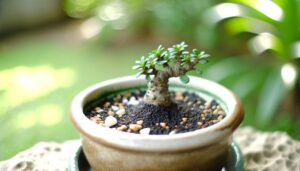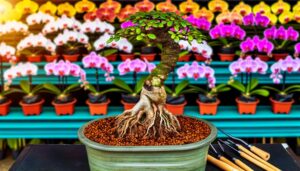How to Grow Azalea Bonsai Indoors Successfully
Azalea bonsai can indeed be grown indoors if their specific horticultural needs are rigorously adhered to. These plants require at least six hours of indirect sunlight daily, ideally from an east-facing window or full-spectrum grow lights.
Maintaining humidity levels at 50-60% and a temperature range of 60-75°F is critical. An ericaceous soil mix that is well-drained and slightly acidic is essential.
Watering should be done when the topsoil is partially dry, using rainwater or distilled water to avoid pH issues. A balanced fertilization regimen and proper pruning post-bloom are also necessary.
Further details provide a thorough understanding of their care.

Key Takeaways
- Azalea bonsai can grow indoors if provided with 6 hours of indirect sunlight daily.
- Maintaining humidity at 50-60% and temperature between 60-75°F is essential for indoor azalea bonsai.
- Use well-drained, moist soil with an ericaceous mix to support healthy indoor growth.
- Regular bi-weekly fertilization with a 30-10-10 N-P-K ratio during the growing season is crucial.
- Prune after blooming and perform regular maintenance to keep the indoor azalea bonsai healthy and aesthetically pleasing.
Light Requirements

Proper light requirements are crucial for the best growth and health of Azalea bonsai trees when cultivated indoors. Azalea bonsai require a minimum of 6 hours of indirect sunlight daily to facilitate photosynthesis and maintain their robust growth.
Utilizing full-spectrum grow lights can effectively mimic natural sunlight, ensuring consistent exposure. It is crucial to avoid direct sunlight, which can scorch the foliage, leading to chlorosis and reduced vigor. Positioning the bonsai near an east-facing window, complemented by artificial lighting as needed, maximizes light absorption.
Empirical studies indicate that inadequate light exposure directly correlates with stunted growth and diminished flowering potential. Hence, meticulous monitoring and adjustment of light conditions are vital for the best cultivation of indoor Azalea bonsai.
Humidity and Temperature
Maintaining an ideal humidity level of 50-60% and a consistent temperature range of 60-75°F is crucial for the healthy growth and development of indoor Azalea bonsai. High humidity supports transpiration, aiding nutrient uptake from the soil matrix.
Conversely, low humidity levels can lead to desiccation, leaf drop, and poor overall vigor. Consistent temperatures prevent thermal stress, which can disrupt metabolic activities such as photosynthesis and respiration. Temperature fluctuations outside the recommended range can induce shock, worsening susceptibility to pests and diseases.
Empirical studies have shown that controlled microclimates with stable humidity and temperature parameters enhance growth metrics and flowering frequency in Azalea species. Therefore, vigilant environmental monitoring is essential for thriving indoor cultivation.
Watering and Soil

Perfect watering practices and soil composition are essential to the robust health and strong growth of indoor Azalea bonsai. Azaleas require consistently moist, well-drained soil; therefore, using an ericaceous mix—a combination of peat moss, pine bark, and perlite—is recommended to maintain ideal acidity (pH 4.5-6.0).
Overwatering can lead to root rot, while underwatering induces desiccation and stress. Empirical evidence suggests watering when the topsoil feels slightly dry to the touch, ensuring thorough hydration without waterlogging.
Utilizing rainwater or distilled water, free of alkaline minerals, helps reduce the risk of pH imbalance. Proper soil aeration, facilitated by perlite or pumice, enhances root respiration and nutrient uptake, necessary for the bonsai's overall well-being.
Fertilization Needs
Best fertilization practices are crucial for the vigorous growth and flowering of indoor Azalea bonsai, requiring a balanced regimen tailored to its unique nutritional needs. Azalea bonsai thrive on a fertilizer specifically formulated for acid-loving plants, with an N-P-K ratio of approximately 30-10-10 during the growing season.
Research indicates that bi-weekly application from early spring to late summer optimizes nutrient uptake. Additionally, micronutrients such as iron, manganese, and zinc are crucial to prevent chlorosis and support robust foliage. Organic fertilizers, like cottonseed meal, can be incorporated to improve soil structure and microbial activity.
It is vital to stop fertilization during dormancy to avoid nutrient burn and to promote natural rest periods essential for plant health.
Pruning and Maintenance

How does one preserve the structural strength and aesthetic shape of an indoor Azalea bonsai through meticulous pruning techniques and rigorous maintenance protocols?
Pruning and maintenance are vital to maintain optimal health and visual appeal. Prune after the blooming period to encourage new growth and to shape the bonsai. Employ sterile, sharp tools to avoid infection and guarantee clean cuts. Regular maintenance includes monitoring for pests and diseases, which can compromise the plant's vitality.
- Deadheading: Remove spent flowers to encourage further blooming.
- Thinning: Trim excess branches to improve light penetration and airflow.
- Wiring: Use wire to guide branch growth, ensuring structural equilibrium.
- Watering: Maintain consistent moisture without waterlogging.
- Soil Maintenance: Replace soil periodically to prevent nutrient depletion.
These steps are essential for sustaining the bonsai's health and aesthetics.
Conclusion
Azalea bonsai can indeed thrive indoors when provided with the precise conditions akin to their natural habitats. Adequate light, consistent humidity and temperature, careful watering practices with well-draining soil, and periodic fertilization are essential. Regular pruning and maintenance guarantee robust growth and aesthetic appeal.
When these conditions are diligently met, the vibrant blossoms and lush foliage of the azalea bonsai can transform any indoor space into a miniature, flourishing botanical sanctuary.






